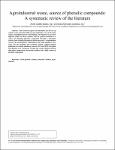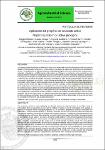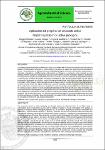Mostrar el registro sencillo del ítem
Agroindustrial waste, source of phenolic compounds: A systematic review of the literature [Residuos agroindustriales, fuente de compuestos fenólicos: Una revisión sistemática de la literatura]
| dc.contributor.author | Cadillo Solano, Annel | |
| dc.contributor.author | Mercedes Cardenas, Santos | |
| dc.date.accessioned | 2023-10-13T23:51:26Z | |
| dc.date.available | 2023-10-13T23:51:26Z | |
| dc.date.issued | 2021-09-08 | |
| dc.identifier.citation | Cadillo, A., & Mercedes, S. (2021). Agroindustrial waste, source of phenolic compounds: A systematic review of the literature [Residuos agroindustriales, fuente de compuestos fenólicos: Una revisión sistemática de la literatura]. Proceedings of the LACCEI international Multi-conference for Engineering, Education and Technology, 137, 175610. http://dx.doi.org/10.18687/LACCEI2021.1.1.137 | es_PE |
| dc.identifier.other | . | es_PE |
| dc.identifier.uri | https://hdl.handle.net/11537/34444 | |
| dc.description.abstract | La presente investigación expone una alternativa de aprovechamiento para los residuos orgánicos generados diariamente por las agroindustrias, una de las principales fuentes de contaminación para el medio ambiente. El objetivo fue mostrar diferentes estudios sobre aquellos residuos con mayor potencial como fuente de obtención de compuestos fenólicos mediante una revisión sistemática de la literatura científica en los últimos diez años. Como fuentes de información se utilizó las bases de datos de ScienceDirect, EBSCOhost y Scielo. Para los criterios de inclusión y exclusión, se consideraron artículos originales publicados en bases de datos científicas, entre el año 2011 y 2020, en inglés y español. Finalmente, los resultados obtenidos demostraron que los residuos de uva, mangostino y maní tuvieron un alto contenido de compuestos fenólicos. | es_PE |
| dc.description.abstract | This research exposes an alternative for the use of organic waste generated daily by agro-industries, one of the main sources of pollution for the environment. The objective was to show different studies on those residues with the greatest potential as a source of obtaining phenolic compounds through a systematic review of the scientific literature in the last ten years. As information sources, the ScienceDirect, EBSCOhost and Scielo databases were used. For the inclusion and exclusion criteria, original articles published in scientific databases, between 2011 and 2020, in English and Spanish were considered. Finally, the results obtained showed that grape, mangosteen and peanut residues had a high content of phenolic compounds. | es_PE |
| dc.format | application/pdf | es_PE |
| dc.language.iso | spa | es_PE |
| dc.publisher | Latin American and Caribbean Consortium of Engineering Institutions | es_PE |
| dc.rights | info:eu-repo/semantics/openAccess | es_PE |
| dc.rights | Atribución-NoComercial-CompartirIgual 3.0 Estados Unidos de América | * |
| dc.rights.uri | https://creativecommons.org/licenses/by-nc-sa/3.0/us/ | * |
| dc.source | Universidad Privada del Norte | es_PE |
| dc.source | Repositorio Institucional - UPN | es_PE |
| dc.subject | Contenido fenólico total | es_PE |
| dc.subject | Extracción | es_PE |
| dc.subject | Residuos | es_PE |
| dc.subject | Agroindustria | es_PE |
| dc.subject | Total phenolic content | es_PE |
| dc.subject | Extraction | es_PE |
| dc.subject | Residues | es_PE |
| dc.subject | Agroindustry | es_PE |
| dc.title | Agroindustrial waste, source of phenolic compounds: A systematic review of the literature [Residuos agroindustriales, fuente de compuestos fenólicos: Una revisión sistemática de la literatura] | es_PE |
| dc.type | info:eu-repo/semantics/conferenceObject | es_PE |
| dc.publisher.country | PE | es_PE |
| dc.identifier.journal | Proceedings of the LACCEI international Multi-conference for Engineering, Education and Technology | es_PE |
| dc.subject.ocde | https://purl.org/pe-repo/ocde/ford#2.11.00 | es_PE |
| dc.description.sede | Trujillo San Isidro | es_PE |
| dc.identifier.doi | http://dx.doi.org/10.18687/LACCEI2021.1.1.137 |







